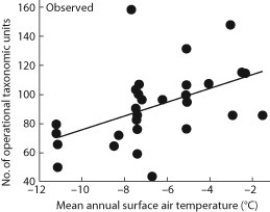Multiple Choice
As fungi play important roles in ecosystem processes as decomposers and symbiont partners, scientists are interested in understanding how global climate change may affect fungal diversity. In 2007-2008, scientists visited the maritime Antarctic, an area of the Southern Hemisphere that is noted to be warming the fastest, to conduct a survey of fungal diversity along a climatic gradient (the most prevalent weather conditions of a region along an incline) . Twenty-nine soil samples were taken along the gradient. Fungal diversity was measured in operational taxonomic units (OTUs) ; one OTU = one cluster, or group, of organisms. Here is a portion of the data collected:
 Source: Newsham, K. K., Hopkins, D. W., Carvalhais, L. C., Fretwell, P. T., Rushton, S. P., O'Donnell, A. G., & Dennis, P. G. (n.d.) . Relationship between soil fungal diversity and temperature in the maritime Antarctic. Nature Climate Change, 6, 182-186.
Source: Newsham, K. K., Hopkins, D. W., Carvalhais, L. C., Fretwell, P. T., Rushton, S. P., O'Donnell, A. G., & Dennis, P. G. (n.d.) . Relationship between soil fungal diversity and temperature in the maritime Antarctic. Nature Climate Change, 6, 182-186.
-What might scientists also predict to find in warmer environments based on the data in the figure?
A) decreased rate of decomposition
B) increased rate of nutrient cycling in the soil
C) increased rates of clear-cutting practices
D) decreased mycorrhizal growth
Correct Answer:

Verified
Correct Answer:
Verified
Q56: Hallucinations, nervous spasms, and even death can
Q57: About 95% of all modern plant species<br>A)
Q58: The evolution of easily modified flower colors
Q59: The heterokaryotic phase of a fungal life
Q60: Which of the following options correctly represents
Q62: One of the factors that helps animal-pollinated
Q63: Threadlike fungal filaments are called<br>A) mycelia.<br>B) hyphae.<br>C)
Q64: Which of the following occurs in the
Q65: Most familiar types of fungi including mushrooms,
Q66: The incomplete decay of dead plants during